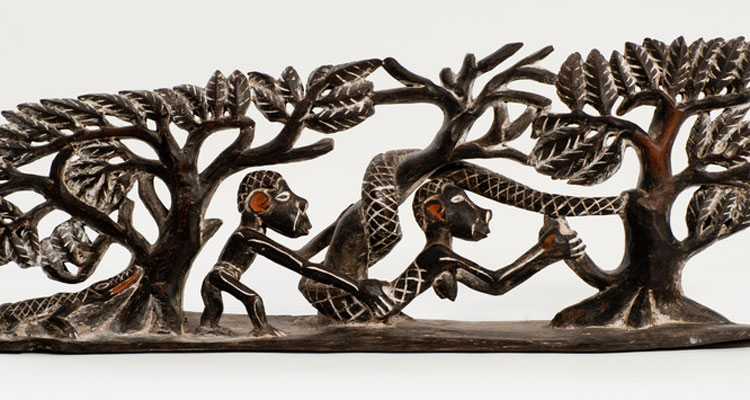Asmat artists from a remote region of New Guinea – two renowned carvers and a master singer and drummer – will visit the University of St. Thomas the week of July 18. They will perform at the 2016 Spirits of Summer Asmat Gala, an annual fundraiser for the St. Thomas-based American Museum of Asmat Art, from 6 to 8 p.m. Wednesday, July 20, in Woulfe Alumni Hall of the Anderson Student Center on the university’s St. Paul campus.
The Asmat are one of the indigenous peoples of the island of New Guinea, which lies directly north of Australia in the southwest Pacific Ocean. Today, the Asmat’s homelands lie within the modern nation of Indonesia. They live in several hundred villages along the numerous rivers that wind through the dense swamps and rainforests of a vast, muddy coastal plain; even today virtually all transportation there takes place by canoe.
The challenges of reaching this part of southwest New Guinea meant the Asmat had little contact with the outside world until the 1950s. Dr. Eric Kjellgren, director of the museum, said the group’s visit to St. Paul “is the first visit to the United States by a group of Asmat artists in over a decade and provides an extremely rare opportunity to meet artists from the culture behind the works now on display at the university.”
Past and present Asmat artists, recognized as among the finest sculptors in the Pacific Islands, created the artworks now preserved in the American Museum of Asmat Art. With more than 2,200 works in wood, fiber and other materials, it is the largest collection of Asmat art in the United States and among the largest collections in the world.
Other Asmat collections are held by major art museums in Europe and across the United States, including the Metropolitan Museum of Art in New York, the de Young museum in San Francisco and the Minneapolis Institute of Arts.
The two master carvers (called ipits) coming to St. Thomas are Biatus Amernat and Feransiskus Yemes from Omanesep, a village known for its strong tradition of wood sculpture and especially for monumental ancestor poles (called bis) that are similar to those on display in The Gallery, located on the second floor of the university’s Anderson Student Center.
Joining them will be Bernat Bicimpari, a master singer and drummer from the village of Syuru.
All three are highly active in the art and ceremonial life of their communities. This will be their first trip outside their homeland and they will be accompanied by guide and translator Andre Liem.
At the July 20 gala, they will demonstrate their carving techniques and perform their singing and drumming. Open to the public, the gala is sponsored by the American Museum of Asmat Art and St. Thomas’ Art History Department and the College of Arts and Sciences. Tickets are $125; to register and for more information visit this website.
During their week on campus, the carvers will create an original work of sculpture in Anderson Student Center Room 231. The carving will be about 8 or 9 feet tall and made from a Minnesota-grown basswood tree.
In the past, most Asmat works were created for use in ceremonies; many honored men and women who recently died and served to assist their spirits to reach safan, the land of the ancestors. While nearly all Asmat today are Catholic, they continue to practice many of their ancestral art traditions and also produce new art forms for sale on the international art market.
“Humans and wood sculptures are closely related in traditional Asmat cosmology,” Kjellgren said. “According to one Asmat origin tradition, the first humans originated as wooden figures, carved by an ancestral being named Fumeripits, who brought the figures to life by drumming. Today’s Asmat carvers and drummers follow in Fumeripits’ footsteps, maintaining and perpetuating the artistic lives of their communities through sculpture and performance.”
The American Crosier Fathers and Brothers began collecting Asmat art when they first arrived there nearly 60 years ago. Their 1,400-piece collection was donated to St. Thomas by the Crosiers and the Diocese of Agats in 2007. The St. Thomas-based American Museum of Asmat Art continues to grow through donations from private collectors and by direct purchase of works in the Asmat region.
Funds raised at the Spirits of Summer Asmat Gala will be used to support the creation of the Bishop Alphonse Sowada Endowed Chair of Pacific Art at St. Thomas. Sowada, who died in 2014, was a Crosier missionary from the United States who first arrived in Asmat in 1961 and became the first bishop of the Diocese of Agats in 1969. Like many members of the Crosier order who served in Asmat, Sowada held a degree in anthropology and encouraged the Asmat people to preserve their culture through art and the continuation of their ritual life.








